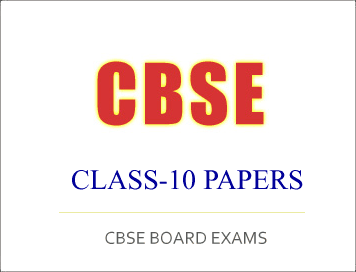CBSE Class-10 Question Papers for IOP/Comptt Examination 2017 : Delhi Scheme, Science
Disclaimer: This website is NOT associated with CBSE, for official website of CBSE visit - www.cbse.gov.in
CBSE Class-10 Question Papers for IOP/Comptt Examination 2017 :
Delhi Scheme, Science
CBSE Class-10 Question Papers for IOP/Cmptt Examination : Science
SUMMATIVE ASSESSMENT – II
SCIENCE
Time allowed : 3 hours
Maximum Marks : 90
Section – A
1. Write the molecular formula of (i) Methane and (ii) Ethanol.
2. Write two different uses of concave mirrors.
3. Name two natural ecosystems.
4. State Modern Periodic Law. What is number of groups and periods in the Modern Periodic Table ?
5. List four characteristics of the images formed by plane mirrors.
6. What is ozone ? Name the chemicals that damage the ozone layer.
7. Varun instead of copying from the black board use to copy regularly from the note book of his friend, Sudhir with whom he sat on the same desk. Sudhir told the teacher about it. The teacher asked Varun to get his eyes checked by a doctor and explained to whole class the reason why Varun copied from Sudhir’s notebook.
(i) What in your view, is wrong with Varun’s eyes and how can it be corrected ?
(ii) If the doctor prescribes Varun to use lenses of power – 0.5 D, write the type of these lenses.
(iii) Write the values displayed by Sudhir and his teacher.
8. What is scattering of light ? Why is the colour of the clear sky blue ? Explain.
9. An object is placed perpendicular to the principal axis of a convex lens of focal length 8 cm. The distance of the object from the lens is 12 cm. Find the position and nature of the image.
10. Define the term magnification as referred to spherical mirrors. If a concave mirror forms a real image 40 cm from the mirror, when the object is placed at a distance of 20 cm from its pole, find the focal length of the mirror.
11. An element ‘M’ has atomic number 12.
(i) Write its electronic configuration and valency.
(ii) Is ‘M’ a metal or a non-metal ? Give reason in support of your answer.
(iii) Write the formula and nature (acidic / basic) of the oxide of M.
12. How does the atomic radius of the elements change on going
(i) from left to right in a period, and
(ii) down a group in the Modern Periodic Table ? Give reason in support of your answer.
13. What is a homologous series of carbon compounds ? List its any two characteristics. Write the name and formula of next higher homologous of HCOOH.
14. (a) Write the functions of the following parts of human male reproductive system :
(i) Testis ; (ii) Vas deferens ; (iii) Urethra ; (iv) Prostate
(b) List any two common pubertal changes that appear in human males.
15. Distinguish between inherited traits and acquired traits giving one example of each. Give reason why the traits acquired by an individual during the life time are not inherited.
16. What is asexual reproduction ? Write the process of budding in Hydra.
17. What are Chromosomes ? Explain how in sexually reproducing organisms the number of chromosomes in the progeny is maintained.
18. List and explain briefly any three methods of contraception.
19. (a) Draw labelled ray diagrams for each of the following cases to show the position, nature and size of the image formed by a convex lens when the object is placed
(i) between its optical centre (O) and principal focus (F)
(ii) between F and 2F
(b) How will the nature and size of the image formed in the above two cases, (i) and (ii) change, if the convex lens is replaced by a concave lens of same focal length ?
20. A person is unable to see distinctly the words printed on a newspaper. Name the defect of vision he is suffering from. Draw ray diagram to illustrate this defect. List its two possible causes. Draw a ray diagram to show how this defect may be corrected
using a lens of appropriate focal length.
21. (a) Write a chemical equation of each of the following types of chemical reactions of organic compounds.
(i) Oxidation reaction
(ii) Addition reaction
(iii) Substitution reaction
(b) What is ethanol ? What happens when it is heated with excess Conc. H2SO4 at 443 K ? Write the role of Conc. H2SO4 in this reaction.

